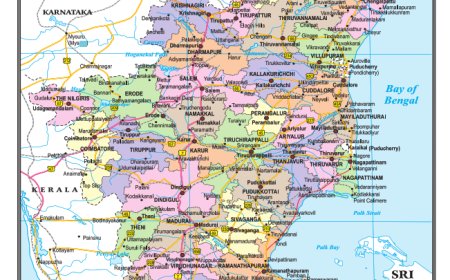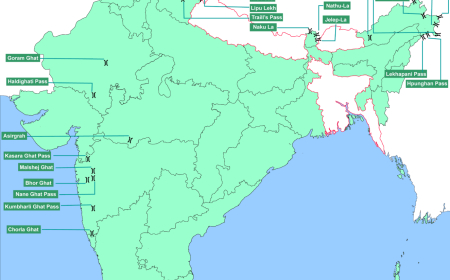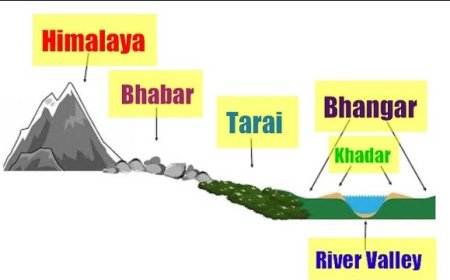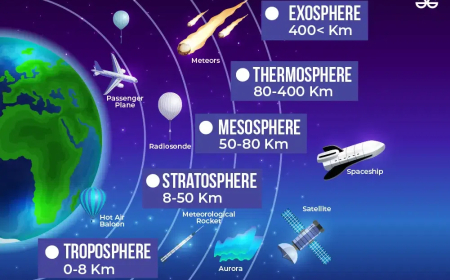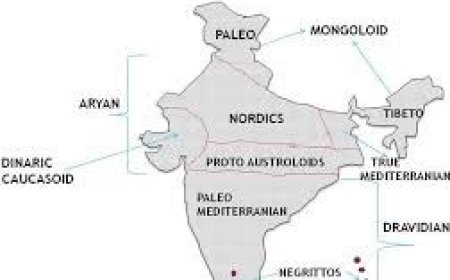Forest
Forest
Forest
-
Tropical Evergreen and Semi Evergreen forests
-
Tropical Deciduous Forests
-
Tropical Thorn Forests and Scrubs/ Tropical Dry Forest
-
Montane Forests, Alpine
-
Mangrove Forests/Tidal/Littoral and Swamp Forest
Tropical Evergreen Forest:
-
Location: Found in areas with 200 cm or more annual rainfall.
-
Climate: Annual temperature is more than 22°C; average annual humidity exceeds 70%.
-
Regions: Western Ghats in Maharashtra, Karnataka, Kerala, Andaman-Nicobar Islands, Assam, West Bengal, Nagaland, Tripura, Mizoram, Manipur, and Meghalaya.
-
Flora: Rubber, mahogany, ebony, rosewood, coconut, bamboo, cinchona, candes, palm, ironwood, and cedar.
-
Exploitation: Not fully exploited due to lack of transport facilities.
Tropical Deciduous Forest:
-
Location: Found in areas with 100 to 200 cm annual rainfall; called 'Monsoon Forests'.
-
Climate: Mean annual temperature is about 27°C; average annual relative humidity is 60 to 70%.
-
Regions: Sub-Himalayan region from Punjab to Assam, Great Plains (Punjab, Haryana, Uttar Pradesh, Bihar, West Bengal), Central India (Jharkhand, Madhya Pradesh, Chhattisgarh), South India (Maharashtra, Karnataka, Telangana, Andhra Pradesh, Tamil Nadu, and Kerala).
-
Flora: Teak, sal, sandalwood, rosewood, kusum, mahua, palas, haldu, amla, padauk, bamboo, and tendu.
-
Products: Fragrant oil, varnish, sandal oil, and perfumes.
Tropical Dry Forest:
-
Location: Found in areas with 50 to 100 cm annual rainfall; transitional type of forests.
-
Regions: East Rajasthan, Haryana, Punjab, Western Uttar Pradesh, Madhya Pradesh, Eastern Maharashtra, Telangana, West Karnataka, and East Tamil Nadu.
-
Flora: Mahua, banyan, amaltas, palas, haldu, kikar, bamboo, babool, khair.
Desert and Semi-desert Vegetation:
-
Location: Also called 'Tropical thorn forests'; found in areas with less than 50 cm annual rainfall.
-
Climate: Low humidity and high temperature.
-
Regions: North-west India (west Rajasthan, south-west Haryana, north Gujarat, south-west Punjab), dry parts of the Deccan plateau (Karnataka, Maharashtra, Andhra Pradesh).
-
Flora: Babul, kikar, wild palms.
Mountain or Montane Forest:
-
Classification: Based on altitude and amount of rainfall.
-
Regions:
-
North-east states (altitude of 1200-2400m): Sal, oak, laurel, amura, chestnut, cinnamon.
-
Altitude of 2400 to 3600m: Oak, birch, silver fir, pine, spruce, juniper.
-
Jammu & Kashmir, Himachal Pradesh, Uttarakhand:
-
Upto 900m: Semi-desert vegetation with bushes and small trees.
-
900 to 1800m: Chir is the most common tree.
-
1800 to 3000m: Semi-temperate coniferous forests.
Alpine Forest:
-
Location: Occurs all along the Himalayas above 2400m altitude.
-
Flora: Purely coniferous trees; oak, silver fir, pine, juniper.
-
Regions: Eastern parts of Himalayas have a large extent of these forests.
Mangrove Forest:
-
Location: Occur in and around deltas, estuaries, and creeks prone to tidal influences; also known as delta or swamp forests.
-
Regions: Delta of the Ganga-Brahmaputra (largest tidal forest, also known as Sundarbans forest), deltas of Mahanadi, Godavari, and Krishna rivers.
TamilNadu
Tropical Evergreen
Montane Temperate
Tropical Deciduous
Tidal Forest/ Mangrove Forest - Where, Characteristics, Plants/Trees, Locations- India, Tamil Nadu; Schemes, MISHTI, Amrit Darohar
Tropical Thorn
Natural Vegetation:
-
Definition: Refers to forest cover.
-
Factors: Landforms, soil nature, temperature, and rainfall control distribution.
-
National Forest Policy (1988): Minimum one-third of the total geographical area must be under forest cover.
-
Current Status in Tamil Nadu:
-
Forest area: 26,419 sq.km.
-
Constitutes 20.31% of the total area.
-
Accounts for 2.99% of India’s forest cover.
-
Forest Types in Tamil Nadu: Varies from wet evergreen to scrub forests.
Forest Types:
Tropical Evergreen Forest:
-
Location: Regions with heavy rainfall.
-
Characteristics: Dense, multi-layered.
-
Regions: Upper slopes of Western Ghats (Tirunelveli, Tenkasi, Kanyakumari, Nilgiris, Coimbatore).
-
Flora: Cinnamon, Malabar ironwood, panasa, java plum/jamun, jack, kindal, ayani, crape myrtle.
-
Semi-evergreen Forests: Found in sub-tropical climate over the Eastern Ghats (Servarayan, Kollimalai, Pachaimalai).
-
Species: Indian mahogany, monkey teak, woolly cassia, jack, mango.
Montane Temperate Forest:
-
Location: Sheltered valleys of Anaimalai, Nilgiris, Palani hills above 1000 meters altitude.
-
Characteristics: Known as ‘Sholas’, evergreen, short trees.
-
Flora: Nilgiri champa, wights litsea, rose apple.
Tropical Deciduous Forest:
-
Location: Margin of semi-evergreen and evergreen forests.
-
Characteristics: Trees shed leaves during the dry season, up to 30 meters height.
-
Flora: Silk cotton, kapok, kadamba, dog teak, woman's tongue, axlewood, siris, bamboos.
-
Economic Importance: Some trees are economically valuable.
Mangrove Forest:
-
Location: Coastal areas, river deltas, tails of islands, sea faces with accretion in progress.
-
Characteristics: Evergreen, moderate height, leathery leaves.
-
Adaptation: Survive in tidal mud and salt water.
-
Flora: Asiatic mangrove, white mangrove, wild jasmine/Indian pivot.
-
Regions: Pichavaram, Vedaranyam, Muthupet, Chatram, Thoothukudi.
Tropical Thorn Forest:
-
Location: Areas with little rainfall, plains up to 400 meters altitude.
-
Flora: Rusty acacia, wheel, neem, palm.
-
Vegetation: Shrubs are common.
-
Regions: Dharmapuri, Ramanathapuram, Virudhunagar, interior districts.
Forest Conservation:
Social Forestry:
-
Urban Forestry: Planting trees in urban areas to improve air quality, provide shade, and enhance the aesthetic value of the environment.
-
Rural Forestry: Planting trees in rural areas for timber, fuelwood, fodder, and other resources to support local communities.
-
Farm Forestry: Farmers plant trees on their farmland to create shelterbelts, prevent soil erosion, and provide economic benefits through timber and non-timber forest products.
National Forest Policy - 1988:
-
Objective: A minimum of 33% of the total geographical area should be under forest cover to maintain ecological balance and environmental stability.
Indian Forest Report:
-
Overview: Biennial report by the Forest Survey of India that assesses the country's forest cover and its changes over time.
-
Importance: Provides data on forest types, density, and health, aiding in forest management and policy-making.
Forest Movements:
-
Chipko Movement: A forest conservation movement in the 1970s in Uttarakhand, where villagers hugged trees to prevent their cutting.
-
Appiko Movement: A similar movement in Karnataka inspired by the Chipko Movement.
Personalities:
-
Sunderlal Bahuguna: Environmentalist and a key figure in the Chipko Movement.
-
Chandi Prasad Bhatt: Founder of Dasholi Gram Swarajya Sangh and a leader in the Chipko Movement.
-
Medha Patkar: Social activist involved in the Narmada Bachao Andolan, advocating for the rights of forest-dwelling communities.
Scheduled Tribes and Other Traditional Forest Dwellers (Recognition of Forest Rights) Act, 2006:
-
Objective: Recognizes and vests the forest rights and occupation in forest land for forest-dwelling Scheduled Tribes and other traditional forest dwellers.
-
Rights: Includes the right to hold and live in the forest land, use minor forest produce, and access, conserve, and manage the forest resources.
Features of the Act
-
The act recognize and vest the forest rights and occupation in Forest land in forest Dwelling Scheduled Tribes (FDST) and Other Traditional Forest Dwellers (OTFD)who have been residing in such forests for generations.
-
The act also establishes the responsibilities and authority for sustainable use, conservation of biodiversity and maintenance of ecological balance of FDST and OTFD.
-
It strengthens the conservation regime of the forests while ensuring livelihood and food security of the FDST and OTFD.
-
It seeks to rectify colonial injustice to the FDST and OTFD who are integral to the very survival and sustainability of the forest ecosystem.
-
The act identify four types of rights:
-
Title rights
-
It gives FDST and OTFD the right to ownership to land farmed by tribals or forest dwellers subject to a maximum of 4 hectares.
-
Ownership is only for land that is actually being cultivated by the concerned family and no new lands will be granted.
-
Use rights
-
The rights of the dwellers extend to extracting Minor Forest Produce, grazing areas, to pastoralist routes, etc.
-
Relief and development rights
-
To rehabilitation in case of illegal eviction or forced displacement and to basic amenities, subject to restrictions for forest protection
-
Forest management rights
-
It includes the right to protect, regenerate or conserve or manage any community forest resource which they have been traditionally protecting and conserving for sustainable use.
-
Who can claim these Rights?
-
Members or community of the Scheduled Tribes who primarily reside in and who depend on the forests or forest lands for bona fide livelihood needs.
-
It can also be claimed by any member or community who has for at least three generations (75 years) prior to the 13th day of December, 2005 primarily resided in forests land for bona fide livelihood needs.
-
The Gram Sabha is the authority to initiate the process for determining the nature and extent of Individual Forest Rights (IFR) or Community Forest Rights (CFR) or both that may be given to FDST and OTFD.
Biosphere Reserves:
-
Criteria: Areas of terrestrial and coastal ecosystems promoting solutions to reconcile the conservation of biodiversity with its sustainable use.
-
Declaration: Declared by national governments and recognized under UNESCO's Man and the Biosphere (MAB) Programme.
-
List and Location: India has 18 biosphere reserves, including Nilgiri, Gulf of Mannar, Sundarbans, and Nanda Devi.
-
UNESCO-MAB: Aims to establish a scientific basis for improving relationships between people and their environments.
Forest and Trees:
-
Importance: Forests and trees play a crucial role in maintaining ecological balance, supporting biodiversity, and providing resources for livelihoods.
Wetlands in India and Tamil Nadu:
-
Definition: Wetlands are areas where water covers the soil, either permanently or seasonally, including swamps, marshes, and bogs.
-
Importance: Wetlands support diverse ecosystems, act as water filters, and provide habitats for numerous species.
-
Ramsar Sites: Wetlands of international importance designated under the Ramsar Convention.
-
Tamil Nadu Leading: Tamil Nadu has the highest number of Ramsar sites in India, followed by Uttar Pradesh.
-
No Wetlands: States without Ramsar sites include Telangana, Chhattisgarh, Jharkhand, Arunachal Pradesh, Meghalaya, and Sikkim.
Ramsar Convention:
-
Purpose: An international treaty for the conservation and sustainable use of wetlands.
-
Tamil Nadu Leading: With the highest number of Ramsar sites in India.
Tamil Nadu Wetlands Mission
-
Tamil Nadu Wetlands Mission is a five-year program launched in August 2022 by the Government of Tamil Nadu to restore the ecological balance of wetlands in the state. The mission's objectives include:
-
Identifying and mapping wetlands
-
The mission will identify and map 100 wetlands across the state.
-
Eco-restoration
-
The mission will restore wetlands using scientific strategies and evidence-based methods.
-
Conserving biodiversity
-
The mission will conserve wetland biodiversity through community-based approaches.
-
Raising awareness
-
The mission will raise awareness about wetland conservation through public campaigns.
-
Research and monitoring
-
The mission will promote research and monitoring of wetland resources to help with effective management.
-
Climate change
-
The mission will focus on climate change adaptation and mitigation activities
Newly Designated Ramsar Sites?
-
Ankasamudra Bird Conservation Reserve (Karnataka):
-
It is a human-made village irrigation tank built centuries back and is spread over an area of 244.04 acres adjoining the Ankasamudra village.
-
Aghanashini Estuary (Karnataka):
-
It is spread over an area of 4801 ha, and is formed at the confluence of the Aghanashini River with the Arabian Sea.
-
The brackish water of the estuary provides diverse ecosystem services including flood and erosion risk mitigation, biodiversity conservation and livelihood support.
-
The wetland also provides livelihoods by supporting fishing, agriculture, collection of edible bivalves and crabs, shrimp aquaculture, traditional fish farming in the estuarine rice fields (locally known as Gazni rice fields) and salt production.
-
The mangroves bordering the estuary help to protect the shores against storms and cyclones.
-
Magadi Kere Conservation Reserve (Karnataka):
-
It is a human-made wetland with an area of nearly 50 hectares which was constructed to store rainwater for irrigation purposes.
-
The wetland harbors two vulnerable species, namely Common pochard (Aythya ferina) and River tern (Sterna aurantia) and four near-threatened species namely Oriental Darter (Anhinga melanogaster), Black-headed Ibis (Threskiornis melanocephalus), Woolly- necked Stork (Ciconia episcopus) and Painted Stork (Mycteria leucocephala).
-
It is also one of the largest wintering grounds for the Bar-headed goose (Anser indicus) in Southern India. It has been declared globally as an Important Bird and Biodiversity Area (IBA).
-
Karaivetti Bird Sanctuary (Tamil Nadu):
-
Water from the wetland is utilized by the villagers for cultivating agricultural crops such as paddy, sugar cane, cotton, corn, and split red gram.
-
About 198 species of birds have been recorded here; some of the important visitors being the Bar headed Goose, Pin-tailed duck, Garganey, Northern Shoveler, Common Pochard, Eurasian Wigeon, Common teal and Cotton teal.
-
Longwood Shola Reserve Forest (Tamil Nadu):
-
It derives its name from the Tamil word, "Solai", which means a ‘tropical rainforest’.
-
The ‘Sholas’ are found in the upper reaches of the Nilgiris, Anamalais, Palni hills, Kalakadu, Mundanthurai and Kanyakumari in Tamil Nadu.
-
These forested wetlands serve as habitats for the globally endangered Black-chinned Nilgiri Laughing thrush (Strophocincla cachinnans), Nilgiri Blue Robin (Myiomela major), and vulnerable Nilgiri Wood-pigeon (Columba elphinstonii).
What are the Other Initiative Taken for Conservation of Wetland?
-
Global Level:
-
Montreux Record
-
World Wetlands Day
-
National Level:
-
Wetlands (Conservation and Management) Rules, 2017.
-
National Plan for Conservation of Aquatic Ecosystems (NPCA)
-
Amrit Dharohar Capacity Building Scheme
-
National Wetland Conservation Programme (NWCP):
-
It was launched in 1985, to tackle threats to vulnerable wetland ecosystems and enhance their conservation.
What's Your Reaction?







